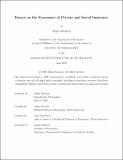Essays on the Economics of Private and Social Insurance
Author(s)
Solomon, Adam
DownloadThesis PDF (9.331Mb)
Advisor
Poterba, James
Finkelstein, Amy
Terms of use
Metadata
Show full item recordAbstract
The first chapter, joint with Sylvia Klosin, studies the 'scope' of insurance. Distinct risks are typically insured separately. A single 'aggregate' contract that pays more when many shocks occur simultaneously, but less when positive shocks offset negative shocks, is utility-increasing absent moral hazard. However, an aggregate contract discourages diversification, leading to a novel insurance-incentive trade-off. We study the US Federal Crop Insurance Program (FCIP), where farmers can choose the `scope' of their policy - whether to insure each field separately, or all fields of the crop as an aggregate unit. Starting in 2009, the FCIP introduced a large subsidy increase for aggregate insurance. We show that farms that moved to aggregate insurance reduced crop diversity and irrigation, farmed less and conserved more land, and insured price risk --- all reducing the diversification of their risks. This increased the variability of farm yield by 14%, raising the fiscal cost of aggregate insurance by about $1.5 billion per year. We derive and estimate a formula for the optimal contract scope. We find that an aggregate policy is never welfare maximizing, but that the optimal policy lies partway between separate and aggregate. More generally, we discuss scope's widespread relevance in insurance design.
The second chapter, proceeds from the fact that increasing climate risk has caused insurance in many locations to become unaffordable or unavailable. I study a novel policy response in Australian home insurance: government provided, mandatory, actuarially fair, reinsurance for cyclone damage. In this scheme, the government reinsures the cyclone risk, while the private market covers the remaining idiosyncratic risk. I find that public reinsurance leads to a 21% decrease in home insurance premiums and an 11% increase in the probability of insurance being offered at all. In terms of mechanisms, I rule out subsidization and show that the ambiguity of the risk has a minimal impact on premiums and insurance offerings. Instead, the entirety of the increase in insurance offered, and much of the decrease in premiums, comes from reducing the implicit costs associated with insuring spatially correlated risk. Increased competition due to insurer entry explains the remaining premium reductions. This isolates the cause of market dysfunction - correlated risk - and suggests that public reinsurance is a cost-effective policy to rehabilitate insurance markets for catastrophic climate risks.
The third chapter, studies bundling in insurance contracts. Every insurance contract bundles risks, and explicit bundling discounts are common. I show theoretically that bundling arises in a competitive market whenever correlation between risk types enables insurer 'cream-skimming': willingness-to-pay for insurance against one risk must be negatively correlated with expected costs from the other risk. I analyze long-term care insurance, in which both-spouse bundles are discounted by 20-35%. I show that cream-skimming incentives are sufficient to explain these discounts, and model-predicted equilibrium bundling discounts closely match empirical discounts. I rule out standard economies-of-scale and differential contract lapsation as alternate explanations of the offered discounts. Counterfactually, banning bundling would raise welfare by 10% by correcting separate-market unraveling, while mandatory family bundling would reduce welfare by 15% by exacerbating advantageous selection.
Date issued
2025-05Department
Massachusetts Institute of Technology. Department of EconomicsPublisher
Massachusetts Institute of Technology